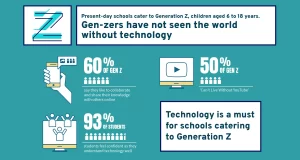Adapting to Three Key Generation Z Traits in Today’s Classroom

As educators, understanding these traits can help create an effective learning environment. Here are three essential Generation Z traits and ways teachers can adapt:
- Digital Natives: Gen Z students are true digital natives who expect constant connectivity and access to information. They crave autonomy in their education and want immediate feedback on assignments. To cater to this trait, teachers can:
- Use educational software: Leverage technology tools like learning management systems, interactive presentations, educational games, and multimedia resources to engage students and make your job more efficient.
- Begin a dialogue: Instead of long lectures, try a variety of teaching methods to keep the class moving. Encourage student participation and active learning.
- Use visuals: Break up large blocks of text with charts, graphics, or multimedia content to make the material more memorable and engaging for students.
- Hold online office hours: Offer virtual office hours for students who prefer instant communication or for parents of younger children who find it more convenient than scheduling formal appointments.
- Provide rationale: Explain why each lesson is important and how it applies to the real world to help students understand its relevance and value.
- Diversity: Generation Z is the most diverse generation yet, with nearly half being racial or ethnic minorities. Teachers should make an effort to understand different cultures and interact with individuals from various backgrounds to foster cross-cultural understanding in the classroom. Some ways include:
- Explore your own culture: Understand your personal biases and recognize the value of cultural backgrounds.
- Make an effort to understand other cultures: Go beyond surface-level interactions by examining how diversity affects students’ self-perception and their view of the world around them.
- Think carefully about language: Be aware of how words are used in different contexts and adapt your communication style accordingly to better connect with students from diverse backgrounds.
- Use diverse books and materials: Incorporate multicultural literature into your curriculum to help students identify with the material and promote cross-cultural understanding.
- Depression and Anxiety: Gen Z students experience high rates of depression (59% increase from 2007 to 2017) due to academic pressure, perfectionism, lack of adequate sleep, or other factors that contribute to mental health issues. Teachers can support these students by adopting techniques such as:
- Work with students one-on-one: Engage Gen Z students through sensitive communication that acknowledges their emotions may impact their learning experience.
- Use positivity techniques: Focus on empowering students by rewarding engagement with verbal praise or recognizing growth milestones regularly.
- Make accommodations: Offer assignment extensions, break tasks into smaller pieces, or create study plans tailored to individual needs while encouraging collaboration among peers for additional support when needed.
- Set the stage for success: Recognise student achievements frequently by celebrating milestones within your curriculum that align with state standards while fostering a safe space for open discussions about mental health concerns if desired by the student community.Authoritative References Used: Pew Research Center; Imagine Learning; Common Sense Media; Gallup; Walton Foundation

Recent Comments